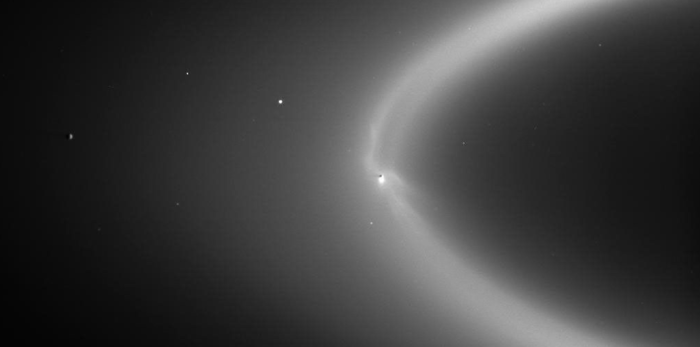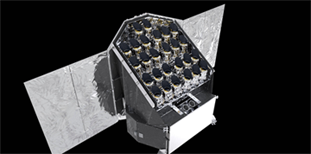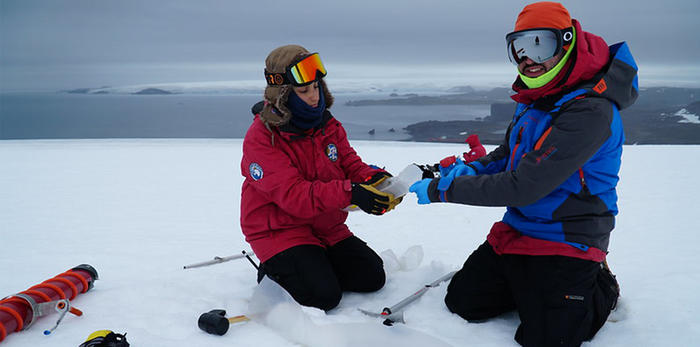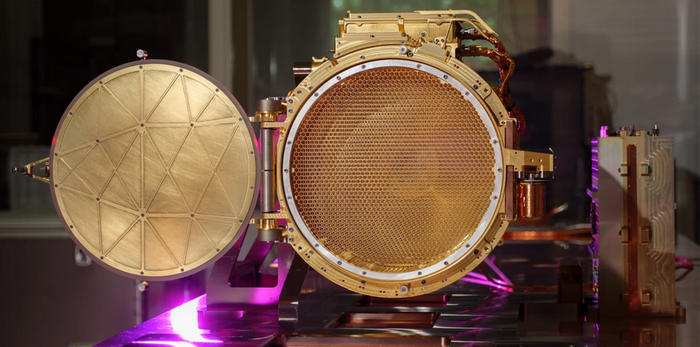Department of Earth Sciences
Service Navigation
Path Navigation
Research projects and mission participation
The Planetary Sciences and Remote Sensing Group participates in the following space missions of ESA and NASA and is funded within the framework of the national space program by the National Space Administration with means of the Federal Ministry for Economic Affairs and Climate Action. Other projects are funded by the Deutsche Forschungsgemeinschaft (DFG) and the European Research Council (ERC).
Current Projects

DIVERSE (DIVerse Exoplanet Redox State Estimations)
project term: 2023 - 2028
The “DIVERSE” project will focus on "Class X planets", which have a strongly reduced interior chemistry. The result would be an atmosphere that was formed by volcanic outgassing, but one which would look quite different to that of Earth or its neighboring planets. These planets would then more closely resemble ice giants like Neptune, where atmospheres are formed from the accretion disc during the creation of planets and are thus dominated by hydrogen and helium.

Dust Model for the Saturnian System
The Saturn Dust Model will provide an accessible representation of micrometeoroid/dust populations in the Saturnian system. The work is funded by the European Space Agency (ESA, ESA Contract No. 4000143242/23/NL/CRS). A main goal is the quantitative assessment of the hazard imposed by impacts of micrometeoroids on future spacecraft exploring Saturn and its satellites.

LRAD (Lunar RADiometer)
How cold does it actually get at the south lunar pole, is it cold enough for ice? With the return of manned spaceflight to the moon, such questions are becoming increasingly relevant. Ice is stable at temperatures below 110 K, even in a vacuum, and is a valuable resource for the Artemis astronauts. LRAD will be travelling to the region around the lunar south pole with the commercial IM-2 mission to investigate temperatures in permanently shadowed craters in search of ice.

PLATO (PLAnetary Transits and Oscillations of stars)
Does a second Earth exist in the Universe? Planet hunter Plato will focus on the properties of rocky planets orbiting Sun-like stars. In particular, Plato will discover and characterise planets in orbits up to the habitable zone – the ‘goldilocks’ region around a star where the temperature is just right for liquid water to exist on a planet’s surface.

JANUS onboard JUICE - Support for Operational Activities
The Jupiter Icy Moons Explorer (JUICE) is a space mission led by the European Space Agency (ESA), launched in 2023. Among JUICE’s scientific instrumentation is the JANUS camera, a high-resolution imager that captures detailed surface features of Jupiter’s moons.

Koregistrierung
In the framework of the “Koregistrierung” project, large-volume single images are automatically combined into coherent global image and topography models of planetary surfaces. The often existing inadequate positional accuracy of the image data is to be corrected by coregistration to other data sets.
Due to the large, heterogeneous data volumes, new methods from the field of artificial intelligence will be applied to enable processing by means of automated procedures.

Natural Analogues for Ocean Worlds
Ocean worlds in the outer Solar System are key locations that may host habitable conditions and even possibly extra-terrestrial life. To prepare as best as possible for upcoming missions, we perform a comprehensive analysis of analogue target material that include natural samples from terrestrial locations.

The SUrface Dust Analyzer (SUDA) onboard Europa Clipper
The Europa Clipper mission from NASA is on its way to the Jovian system and will investigate the habitability of the icy ocean moon Europa. The SUrface Dust Analyzer is an onboard mass spectrometer that will analyze small ice grains ejected from the moon and provide their chemical composition.

SPP 1883: Building a Habitable Earth
Over a period of 6 years, DFG is funding research projects within its SPP framework (DFG-Schwerpunktprogramm) "Building a Habitable Earth". The SPP will contribute to the still open question how Earth became the only known habitable planet. In a concerted approach the SPP will address this eminent issue by involving different earth science disciplines like geology, geochemistry, planetology, cosmochemistry, geobiology and geophysical modelling.

SPP 1992: Exploring the diversity of extrasolar planets
The SPP 1992 addresses the diversity and complexity of exoplanets. It links observational methods for planet detection and characterization with theory and modeling.

Interplanetary and Interstellar Dust
The composition of interstellar dust in our Solar System was analyzed in situ by the Cassini spacecraft with the Cosmic Dust Analyzer. For the future mission Destiny+ by JAXA a similar dust analyzer is being developed at the moment to conduct flyby exploration of an asteroid known to be a parent body of a meteor shower.

Dust in Saturn's Ring System
The composition of Saturn’s rings as well as mineral dust at Saturn was determined with the Cosmic Dust Analyzer (CDA), which is the only German instrument on-board the Cassini spacecraft. The project focuses mainly on the investigation of Saturn's E ring, as well as on exogenic mineral dust that does not stem from Saturn’s ring system.
Image Credits

DIVERSE_projectpic
Image Credit: —

Enceladus and Saturn's E-ring
Image Credit: NASA/JPL/Space Science Institute

LRAD
Image Credit: —

Bild1
Image Credit: —

janus
Image Credit: —

Logo Koregistrierung
Image Credit: —

Antarctica
Image Credit: Maryse Napoleoni

SUDA
Image Credit: —

SPP1883_projectpic1
Image Credit: Wikimedia (https://foundation.wikimedia.org/wiki/File:970525-Damavand-IMG_6598-2.jpg)

SPP1992
Image Credit: SPP 1992 Exoplanet Diversity / Nico Bartmann

cosmic dust
Image Credit: Hope Ishii/University of Hawaii (dust particle); NASA/JPL (CDA instrument)

saturn
Image Credit: NASA/JPL-Caltech
Finished Projects

Habitat-OASIS
project term: Feb 01, 2017 — Apr 30, 2023
The ERC-funded project 'Habitability of Oceans and Aqueous Systems on Icy Satellites' (Habitat-OASIS) will mainly focus on investigations of the icy moons Enceladus at Saturn and Europa at Jupiter, which both have a very high astrobiological potential. Data from Enceladus was collected with the Cosmic Dust Analyzer experiment during the Cassini Mission until 2017. A future mission to Europa will carry a similar experiment to explore the subsurface ocean of the Jovian moon.

Dawn Mission
project term: Nov 01, 2015 — Aug 31, 2020
From 2007 until 2018 the US space probe Dawn was on its mission to explore the small bodies Vesta and Ceres in the asteroid belt between Mars and Jupiter. The NASA-mission aimed at investigating the formation and evolution of these bodies to find clues to the solar system’s early history. In July 2011 Dawn arrived at its first target, the asteroid Vesta. For one year, the probe collected scientific data of Vesta before going on a journey for two and a half years to its second mission object, the dwarf planet Ceres.

Cassini-Huygens Mission
project term: Jul 01, 2015 — Dec 31, 2019
Journeys to planets and moons of the Outer Solar System always pose a great challenge to space-mission design and conduct. Within the framework of the Cassini-Huygens mission US and European space agencies jointly succeeded in sending a probe and a lander to the Saturnian system, over 1 billion kilometers away. From 2004 until 2017, instruments aboard the Cassini spacecraft continuously collected scientific data. Thousands of stunning images have to be processed and interpreted now. Scientists of the Planetary Sciences and Remote Sensing Group were involved in the Cassini camera experiment, the Imaging Science Subsystem (ISS).

Collaborative Research Centre Transregio-170
project term: Jan 01, 2016 — Dec 31, 2019
In the Collaborative Research Centre „Late Accretion onto Terrestrial Planets“, scientists from five institutions (Freie Universität Berlin, Technische Universität Berlin, University of Münster, German Aerospace Center, Museum für Naturkunde) investigated the late accretion history of planetary bodies in the inner solar system from 4.5 to 3.8 billion years ago.

HRSC on Mars Express
project term: Jan 01, 2020 — Nov 30, 2022
Mars Express is the first European mission to Mars. Since its arrival in 2003, the experiments aboard the spacecraft have provided important clues on surface geology and morphology, the subsurface, the atmosphere, the history of water and the question of life.
One experiment on the spacecraft is the High Resolution Stereo Camera (HRSC) which aims at global multispectral and three-dimensional coverage of the Martian surface with a resolution of up to 10 meters per pixel.

iMars webGIS
project term: Jan 01, 2014 — Mar 31, 2017
The iMars project focuses on developing a user platform for Mars surface science, consisting of a consistent set of data products of Mars from the 1970s to the present day. The concept aims to generate a webGIS using imaging data from NASA and ESA missions; including specific tools for producing, exploring and analyzing data products for studies of surface changes over time.

TRR170: Late Accretion onto Terrestrial Planets
project term: Jan 01, 2020 - Dec 31, 2023 (2nd funding period)
The major theme of the collaborative research centre TRR 170 'Late Accretion onto Terrestrial Planets' is to understand the late growth history of the terrestrial planets, from the last giant collisions with Moon- to Mars-sized planetary embryos to the subsequent late bombardment with smaller objects.

Planetary X-Ray Fluorescence Spectrometer
project term: Apr 01, 2013 — Sep 30, 2015
The US Apollo- and the Russian Luna-missions returned hundreds of kilograms of surface rocks from the Moon to the Earth which have been used for detailed rock analysis. We therefore have high-precision geochemical information from very few locations on the Moon, whereas information about the rest of the Moon's surface is sparse. The main objective of developing a planetary X-ray fluorescence spectrometer (XRF) is the design of an experiment that allows us to precisely determine the geochemical composition of rocky surfaces from orbit.

HGF Helmholtz Alliance
project term: Apr 01, 2008 — Mar 31, 2013
The Helmholtz Alliance “Planetary Evolution and Life” under the coordinative direction of the DLR Institute of Planetary Research in Berlin-Adlershof examines the correlation between life and the formation and evolution of planets in our solar system. The focus of studies is planet Mars, which is investigated from its interior to its atmosphere.
Image Credits

Enceladus plume
Image Credit: NASA/JPL-Caltech

dawn
Image Credit: NASA/JPL-Caltech

cassini
Image Credit: NASA/JPL-Caltech/Space Science Institute

moon
Image Credit: Dylan O’Donnell (Web)

mex
Image Credit: ESA

imarsWebGIS_adjusted
Image Credit: ESA/iMars (UCL/FUB/EPFL/UNOTT/UoS)

TRR170
Image Credit: www.earthspacecircle.blogspot.de

XRF Entwicklungen
Image Credit: Freie Universität Berlin

HGF Helmholtz-Allianz
Image Credit: ESA/DLR/FU Berlin (G. Neukum)
